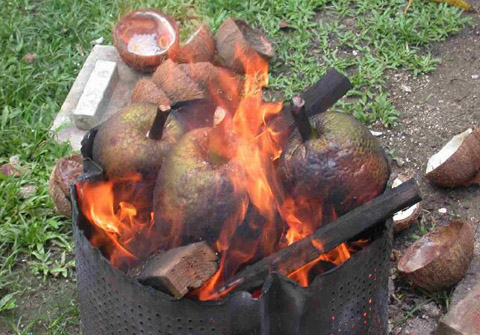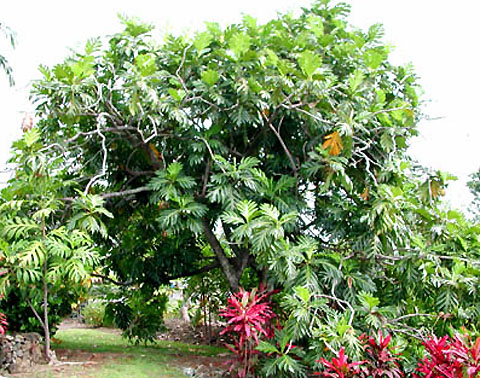Birds and Plants of Kauai:
Ulu - The Breadfruit Tree
by Linda Pascatore on 31 December 2006
The Hawaiian Ulu, or Breadfruit (Artocarpu altilis), is a fast growing tropical tree in the fig family, which can grow to 80 feet tall. with large lobed, leaves. The leaves are beautiful; large, deep green and deeply lobed. The fruit is round and light green, about the size of a honeydew melon, and can weigh up to 10 pounds. Milky, gummy sap begins to leak from the ripe fruit. The fruit is very starchy, and tastes a little like potato or fresh baked bread when cooked,
thence the name breadfruit.
Breadfruit was native to New Guinea, and was one of the canoe plants brought by Polynesians to the Hawaiian Islands. It is an important part of the Hawaiian Agroforest, a natural looking forest found on most inhabited Polynesian islands.
The agroforest is a collection of food trees and plants which were not cultivated in gardens, but planted in forests. This was an early permaculture system which worked well to provide food with minimal work or cultivation. Breadfruit was later picked up by sailors to Polynesia and the Philippines and brought to Mexico, Central America, and the West Indies.

giant ulu tree leaves dwarf not fully mature coconut sized breadfruit
Although seeded breadfruit do reproduce from seeds, seedless breadfruit must be propagated from cuttings. Male and female flowers grow on the same tree. The male flower is club shaped with yellow skin, and the female has a larger receptacle. The fruit is a large cluster of the plants ovaries, which are hexagonal disks fused together and developed from the multitude of tiny flowers. When green, the fruit is hard and the inside white and starchy. When ripe, the inside
becomes yellowish and pasty, and fragrant. There are brown striped, oval seeds about 3/4 inch long in the seeded varieties. In the South Pacific, a mature breadfruit tree can yield 50 to 150 fruits per year.
The Polynesians roasted breadfruit in an imu--an underground oven containing heated rocks, sometimes stuffing it with coconut. Breadfruit can also be boiled and eaten as a vegetable. The ripe fruit can be peeled and fried in sugar until browned, or baked whole, or steamed. It can also be mixed with other vegetables and meat into a stew. In some parts of polynesia and micronesia, the fruit is fermented into a paste called masi. Hawaiians often mixed mashed breadfruit
with poi made from taro, which was called Poi ‘ulu. If eaten raw, breadfruit can act as a laxative. Seeds can be be roasted and eaten with salt, and provide a protein source.
The wood of the breadfruit tree is strong and termite resistant, and is used in building. Hawaiian drums, spears, and surfboards were made from the trunks of the trees. Leaves can be used for livestock feed. The gummy latex sap was used by the Hawaiians to catch birds who alighted it, for their valued feathers. Some feathers were plucked from the birds, the sap cleaned from their feet, then they were released. The latex was also used for boat caulking. Hawaiians also
used the sap medicinally for healing sores and infection in and around the mouth.

breadfuit being roasted in fire in Tahiti
My husband and I obtained a Breadfruit seedling that grew in our friend’s compost pile about three years ago. The tree is now over 20 feet tall, with beautiful leaves that are 3 feet long. It recently produced male and female flowers, and we are hoping for our first harvest sometime soon.
In Hawaiian legend, the God Kuka’ilimoku brought his mortal family through a famine by burying himself in the ground and then transforming to grow as a breadfruit tree. He said to his wife, “Eat some, feed our kids”, and thus his descendants survived the famine.
The ‘Ulu has nurtured the Hawaiians throughout their history, and continues to do so today.
Excerpts from a great site dor information about the uses of breadfruit at http://ulucookbook.com/
The breadfruit, or ulu is this cook’s delight. In its green, immature state, it works in all my recipes that call for artichoke heart. When still green but mature, it is my potato and sometimes rice substitute. When ripe, I use it in place of sweet potato, yam, pumpkin, chestnut and banana. But the ripe, roasted ulu filled with butter and brown sugar will always be my sentimental favorite because this
is the way my grandmother introduced ulu to me. In her way, whenever there was something new to be had, she would say to me; “you wait ‘til pau cook, ono.” It was always true. Whatever she cooked, was wonderfully good...
Breadfruit continues to be used as a primary food source in the Pacific Islands of Micronesia and Polynesia (Tahiti, Tonga, Fiji, Samoa, Mauritius, Cook Islands, Mariana Islands, Marquesas, Society Islands, Solomon Islands, Vanuatu and Yap). Breadfruit is also found in Indonesia, Philippines, the Seychelles, the Caribbean and in Africa. It was used In Hawaii more for its plant products including wood for buildings
and canoes, fiber for cloth and latex as an adhesive for catching birds and caulking canoes...
|




